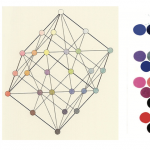The English architect William Benson developed a color system for practical application in the decorative arts. He kept well informed on the scientific findings in the color field. With experience in pigment mixture as well as his own experiments with a prism and mixtures, Benson fully understood the difference between light and colorant mixture.
In 1868, Benson published ‘Principles of the Science of Colour’, which describes a cubic color system. Based on this system, he derived rules of color harmony for color-design use. Later editions appeared in 1872, 1876, and 1886. Benson attempted to cover the totality of color sensation in appropriate geometric model named the Natural System of Cours. Benson’s system is a conceptually additive one. He considered spectral colours to best approximate pure color sensations:
In their binary mixtures, the primary colours red, green and blue form the secondaries, taken to complement the primaries, as determined with the help of edge spectra.The cube stands on its black corner, and three edges extend outwards to the basic colours of red, green and blue.

From the top, the edges lead to a yellow, a “sea-green” and a pink corner. Benson’s cube contains 13 main axes which he divides into three groups:
‘Primary axes’, connecting the central points of opposing side, meaning that the primary colours changes involving 3 axes.
‘Secondary axes’, connecting the middle points of opposing edges, meaning that two primary colours will change involving 6 axes.
‘Tertiary axes’, joining opposing corners meaning that all the three primary colours will change involving 4 axes.
Benson gave exact colour names to all the many points;
He named all the colours on his cube,mostly in name pairs to accurately describe the intermediacy of the colours, and where they would lay spatially. His model might be one of the first three dimensional color model.
